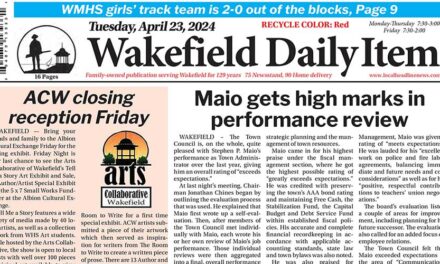Published in the December 8, 2015 edition.
By MARK SARDELLA
WAKEFIELD – Nearly two years after they were empaneled, there appears to be little agreement among members of the Lake Quannapowitt Water Quality Committee when it comes to how to control the Lake’s blue-green algae (cyanobacteria) problem.
In terms of short-term, “in-Lake” solutions, the two main choices seem to be chemical treatment with aluminum sulfate (alum) or the deployment of solar-powered, floating mechanical water circulators called SolarBees.
But in an effort to get a consensus, at last night’s meeting at Town Hall, committee chairman and Town Engineer Michael Collins handed out to committee members a sheet listing all of the various approaches that the committee has considered at its twice monthly meetings since early 2014.
Each committee member was asked take home a sheet and vote on each of the approaches listed and return their votes to Collins. Collins said that he would them compile the results into a summary sheet to give to Town Administrator Stephen P. Maio and the Board of Selectmen to see how they want to proceed.
The sheet included 13 possible “in-Lake” solutions and 10 choices for “land side” control, consisting mainly of ways to reduce the amount of phosphorus in the Lake, since the chemical fuels the growth of the cyanobacteria.
For each choice the voting options were “Yes,” “No” or “O” (defined as a “Yes vote for further pursuing and cost-effective optimizing option).
The committee spent considerable time discussing what a “Yes,” “No” or “O” vote would mean. There was also a suggestion to add a fourth voting option: “E” for “emerging technology.” The group also agreed to change the meaning of an “O” vote to “recommend but ensure cost effectiveness.”
In addition to the SolarBees and the alum treatment, the sheet handed out by Collins listed the following “in-Lake approaches: copper sulfate treatment, algae control ultrasonic, aeration-bioaugmentation, dredging, Beemats, stormwater system diversion to Lake Quannapowitt/flushing, algae harvesting, organic sediment layer removal, algaecide treatment, herbicide treatment and altering the Lake outlet to skim off water surface algae.
Choices for longer-term, land side approaches included: fertilizer/runoff nutrient control, watershed control/green infrastructure, leaf collection/composting, street sweeping, catch basin cleaning, stormwater phosphorus removal systems, shoreline riparian zones, reducing impervious cover, consolidating and treating drains and enhanced infiltration.
There was much discussion on how the various choices should be defined. Member Dennis Cloherty took exception to the way that Collins had characterized his idea to unblock several streams from Reading that once fed the Lake and restore the natural high-water marks. On the sheet Collins listed that choice as “storm water system diversion to Lake Quannapowitt/flushing.”
Member Alison Simcox wanted to split the alum treatment into two separate choices: “low dose” and “elimination dose.” She favored a low dose alum treatment to address the immediate problem in conjunction with some of the longer term “land side” controls to decrease the flow of phosphorus into the Lake.
But committee member Jim Murphy said, “As a chemist, I wouldn’t dump another chemical in that Lake.”
Collins maintained that using an algaecide was “just asking for another chemical problem down the road.”
Murphy suggested trying the SolarBees, claiming that at another Massachusetts lake the SolarBees had disrupted the growth of the algae. He suggested coupling that approach with storm drain treatment.
But Simcox insisted that the other lake that Murphy was citing was not comparable to Lake Quannapowitt and doubted the effectiveness of the SolarBees.
At one point, committee secretary Bill Connelly attempted to move the discussion along.
“I think we’re over-thinking this,” Connelly said. “Let’s decide. We’ve got enough information.”
Eventually, Collins agreed to edit the some of the terminology on the list of possible solutions and post the edited version online. Members were asked to look at the revised list and submit their votes online.




